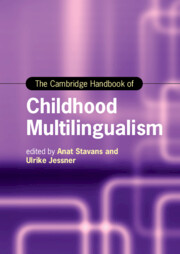Book contents
- The Cambridge Handbook of Childhood Multilingualism
- Cambridge Handbooks in Language and Linguistics
- The Cambridge Handbook of Childhood Multilingualism
- Copyright page
- Contents
- Figures
- Tables
- About the Editors
- Contributors
- Acknowledgments
- Multilingualism Is Not Bilingualism +1: An Introduction
- Part One Becoming and Being a Multilingual Child
- Part Two Cognition and Faculties in Multilinguals
- Part Three Family Language Policy
- Part Four Language(s) and Literacy of Multilingual Children through Schooling
- Part Five Socialization in Childhood Multilingualism
- 21 Building a Plurilingual Identity
- 22 Multilingual Parenting in the United States: Language, Culture and Emotion
- 23 The Development of the Heritage Language in Childhood Bi-/Multilingualism
- 24 Social Cohesion and Childhood Multilingualism in South Africa
- 25 Growing Up in Multilingual Societies: Violations of Linguistic Human Rights in Education
- Part Six Multilingual Children’s Landscape
- Subject Index
- Country Index
- Language Index
- References
22 - Multilingual Parenting in the United States: Language, Culture and Emotion
from Part Five - Socialization in Childhood Multilingualism
Published online by Cambridge University Press: 18 August 2022
- The Cambridge Handbook of Childhood Multilingualism
- Cambridge Handbooks in Language and Linguistics
- The Cambridge Handbook of Childhood Multilingualism
- Copyright page
- Contents
- Figures
- Tables
- About the Editors
- Contributors
- Acknowledgments
- Multilingualism Is Not Bilingualism +1: An Introduction
- Part One Becoming and Being a Multilingual Child
- Part Two Cognition and Faculties in Multilinguals
- Part Three Family Language Policy
- Part Four Language(s) and Literacy of Multilingual Children through Schooling
- Part Five Socialization in Childhood Multilingualism
- 21 Building a Plurilingual Identity
- 22 Multilingual Parenting in the United States: Language, Culture and Emotion
- 23 The Development of the Heritage Language in Childhood Bi-/Multilingualism
- 24 Social Cohesion and Childhood Multilingualism in South Africa
- 25 Growing Up in Multilingual Societies: Violations of Linguistic Human Rights in Education
- Part Six Multilingual Children’s Landscape
- Subject Index
- Country Index
- Language Index
- References
Summary
In this chapter we explore the perceptions and practices of US bilingual or multilingual families with young children, focusing mostly on research with families from Latin American backgrounds and paying close attention to the intersection of language, culture and emotion. We describe who is bi or multilingual in the US, examine why and how US families choose to raise children bi or multilingually, and explore how families use their multiple languages as a child-rearing strategy.
- Type
- Chapter
- Information
- The Cambridge Handbook of Childhood Multilingualism , pp. 515 - 536Publisher: Cambridge University PressPrint publication year: 2022



